Tips for Driving in Ireland
Are you planning a self drive vacation in Ireland but you are worried about driving on the left hand side? Or just curious to get some tips for you Ireland road trip? Here I have all your questions about driving in Ireland answered! Also my personal tips about car rental and safety.
We moved to the Republic of Ireland from the Netherlands a couple of years ago. The first thing we did was to take a driving vacation in Ireland.
Although we do not experience any particular difficulties driving in Ireland, some people do get nervous about driving here for the first time. There are some valid reasons for this which I shall try and describe in this post.
I am here to give you all the tips to ensure you are as confident as possible to drive in Ireland‘s left hand side roads.
When people ask ‘how dangerous is driving in Ireland’? I normally reply by saying ‘it is as dangerous as you want to make it’.
In this post, I will also give some tips on driving in Ireland. We often do road trips here and there are some things that are just handy to know if you are going to be out on Ireland roads.

Rural road with no division. Slow down and make space when you get traffic from the opposite direction.
Ireland driving tips
Outside of its cities, Ireland does not have a very good public transport system (serious understatement), so it is very likely that if you are wanting to see some of the beautiful real old Ireland you will need to rent a car to get there.
If fact a driving tour of Ireland is by far the best way to get to see the country. Driving around Ireland is really great fun as the roads can be challenging and you will see spectacular views in many places.
Like this:

Inch beach, co Kerry
or this amazing pass on the Ring of Kerry:

Conor Pass, co Kerry
Driving in Ireland as an American is not really the same as being at home. The roads are narrower and people do tend to drive quite fast (they are used to the roads normally).
And often you will need to leave the comfort of the motorway to actually see the best of the country, and drive some lovely country roads to get to where you want to go.
But whatever you do, or wherever you go, driving through Ireland will be a wonderful experience that will stay with you for ever.

The best tips for driving in Ireland
Tips for how to drive in Ireland
What side is driving in Ireland?
One of the first things you will notice when driving in Ireland for the first time, is that the Irish drive on the left-hand side of the road. This, for me, being originally British, is normal as it dates back to the times when the whole of Ireland was part of the UK, almost 100 years ago.
Now, of course, the Island of Ireland is split into The Republic and Northern Ireland, both of which drive on the Left Hand Side (LHS), but only Northern Ireland is part of the UK.
Driving in the Republic of Ireland x Northern Ireland
If you are on a self drive Ireland itinerary it is likely that you will drive through both the Republic and Northern Ireland. here are a few things to note:
- British Pounds x Euro
It is useful to note therefore that in Northern Ireland they use British Pounds and in the Republic they have the Euro for tolls, so you should have both currency with you, cash preferably! (some tolls in the Republic of Ireland ONLY accept cash!).
- Km/h x MPH
When you cross the boarder you need to get used to the speed unit differences. In the Republic of Ireland signs are in Kilometers per hour (km/h) while in Northern Ireland signs are in Miles per hour (mph).
The cars you rent will have both units on its dashboard, you just need to get used to looking at the right figures to ensure you keep at the speed limit.
- Give-way/Yield/Stop
The ‘Give-way’ signs you get in the UK are replaced by ‘Yield’ signs in the Republic – these, together with the ubiquitous ‘Stop’ sign will indicate when you need to stop.
- Language
In the Republic of Ireland the signposts are in Both Irish and English while the signs in Northern Ireland are only in English.

Small roads will take you to some of the best drives in Ireland
Common problems Righ Hand Side drivers may have on a self driving Ireland vacation
If you are used to driving on the Righ Hand Side (RHS) it may take a little bit of adjusting to driving on the Left Hand Side (LHS), especially if this is your first time or if you haven’t driven on the opposite side for some time.
Because there is easy accessibility to the Republic from Europe and vice versa via ferries, many vacation makers may come over to the Island with their own continental RHS cars. So basically you will find in Ireland both RHS and LHS cars driven by both RHS and LHS drivers.
Even if you are an experience driver your brain is going to play tricks with you when you change the driving side. Here are a few challenges that RHS drivers experience when first driving on a LHS car:
- You grab the window winder instead of the stick shift
If you prefer driving a manual car or rent one just because it is cheaper (it is cheaper!) you will find yourself reaching for the window winder until you get used to it.
It is a good idea to rent an automatic car if you are worried about this. It is one less thing to think about while you are adjusting to the other things around you.
The pedals are of course in the same place: clutch, brake, accelerator, left to right, so that should not pose a problem.
- Roundabouts go clockwise instead of anti-clockwise
This can theoretically be awkward if you are daydreaming and there are no other cars around to show you the way.
Normally there should be blue arrow signs or chevrons to point in the right direction, but, this is Ireland….
- On an empty road, you may suddenly forget where you are and drive on the right by mistake
Until someone comes driving at you on your side of the road. This I have done several times in the past! So the message is; you have to be alert and aware at all times.

A sign showing that there is a side road on the right coming ahead but you have the priority here.
Otherwise, it is not too tricky. Just be aware that if you are on the main road you will probably have right of way to vehicles coming from the left or right. But it should be signposted.
Driving rules in Ireland
-
Roundabouts
Roundabouts are useful things to have at crossings and work very well in the UK. However, if you approaching a roundabout, then it can sometimes be a bit confusing in Ireland, I have found.
Normally you will then give way to vehicles coming from the right on the roundabout when you are trying to enter it. Just take your time and enter the traffic when you have room. They are normally fairly well signposted.
However, you may find that some drivers are quite slow at taking their right of way. In some countries drivers do not hesitate on taking their right of way, but we have found that Irish drivers do…..
-
Speed limits
The speed limits in Ireland are shown in kilometers per hour in black text on a circular sign with a white background and red border.
These signs will indicate changes to the speed limit in the place you are at. There are speed cameras in some places.
In general, these are the speed limits you can expect:
- Town and city speed limits (50 km/h)
- National road speed limits (100 km/h)
- Regional and local speed limits (80 km/h)
- Motorway speed limits (120 km/h)
- Special speed limits (30 km/h or 60 km/h)
In rural Ireland there are some roads where it is almost impossible to drive to the speed limit as it is set too high, so do not take the speed limit as a recommendation, but rather as a guide, and use it as a maximum.
Beware representatives of the Garda Síochána (the police) may stop and fine you if you are speeding (they do contract this work out to private companies, who are authorized to do this).
Often there are signs showing the speed limit as you enter a town or village.
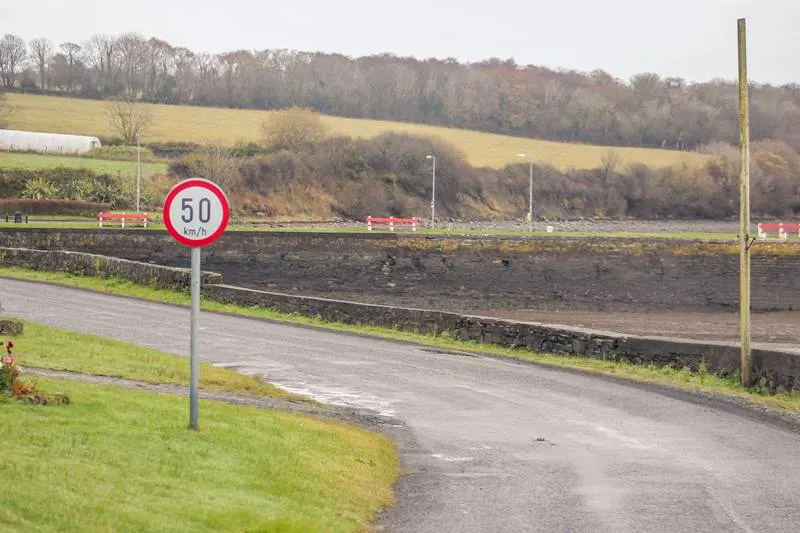
50km/h is usual for town and villages centre

You may also find special speed limits from 30km/h to 60km/hr in cities, towns and villages
If you are in doubt drive at the speed at which you feel safe but keep to within the speed limits. You may get overtaken by crazy Irishmen/women, but do not be encouraged to race them – they probably need to get somewhere fast.
Often you will see speed signs in the country roads where you may doubt how correct they are:
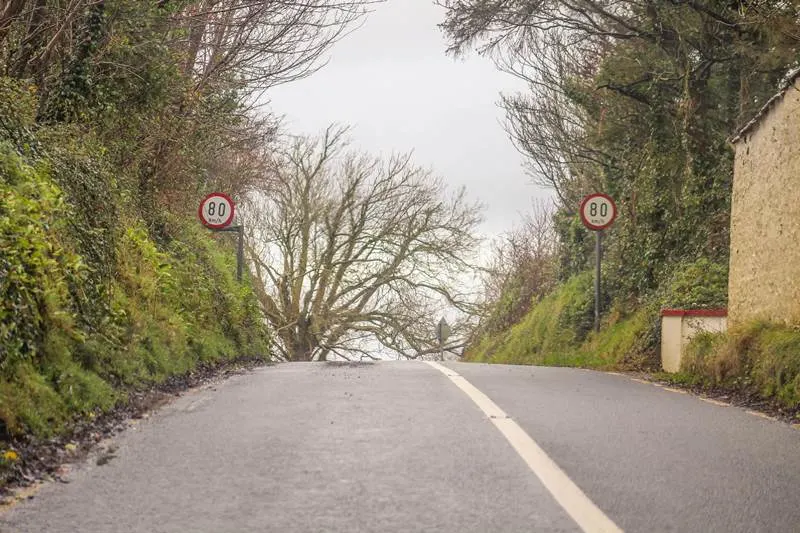
Leaving the town
Just remember, use your common sense and do not drive faster than is safe.

Winding road in Ireland
Just follow the speed limits shown. The restriction will often end with a 100km sign on the same pole as a sign saying ‘Drive Carefully’ or something similar!

Regional roads usually have speed limits of 80km/h
-
Motorways and dual carriageways
Motorways generally have a speed limit of 120km/hr, but you may find that the motorway suddenly ends and becomes a dual carriageway (100km/hr) without you realizing.
This may mean that the central barrier disappears and people suddenly start turning right. Motorways are generally marked with blue road signs.
The general rule is to stay in the left-hand lane unless you are going to overtake. Do not overtake on the left, as it could be considered careless driving unless the car on the right-hand lane is turning right.
So the message is, do not hang around in the right-hand lane (fastest lane) as you will slow down faster drivers. Overtake and move back to the left.
-
Toll roads
Occasionally you will have to stop to pay a toll on the roads.
Be aware that not all toll gates take credit cards. For some you HAVE to pay in cash, so make sure you have some Euro’s on you before you set-off.
It can be embarrassing if you do not have cash and there is a mile-long queue building up behind you! #askmehowiknowit
Around Dublin there is a very annoying barrier free toll on the M50. You can see the signs above the road. You need to download the app to pay the toll within 24 hours or they double the fee. This can be awkward if your normal country is not Ireland – you may not find the app. You can also pay here.
Many forget to do this of course and end up paying more. Make sure you ask the rental car firm about this before you set-off. Often they pay the fee for you and include in your bill, but you need to know beforehand.
Signposting in Ireland
Sign posts in Ireland come in different colors:
- Blue Signs; indicate motorways (an exception is that car parking signs are also in blue)
- Green signs; indicate national roads
- White Signs; indicate regional or local roads
- Yellow Signs are for warnings
- Brown Signs; will inform you about tourist information and attractions

-
Directional signage
When driving in Ireland road signs can sometimes be a bit confusing, to say the least.
I remember my first trip to Ireland following some rural signs to get to a place we were heading for.
The sign said 5 km to our destination, and then 5 km later it said it was another 6km to go! We got there in the end 🙂 , but the message is not to rely too much on road signs.
Sometimes people turn them 180 degrees to point the opposite way in the countryside, just for a craic! You could end up on a road like this : 🙂

In rural Ireland you will often drive single track roads
So it is generally wise to check the map to see which way you really wish to travel.
Near us, there are signposts that send people (tourists) on the main roads to keep them off the back roads, but send them MILES out of the way, sometimes doubling the journey distance. This may not be the best way to get from A to B.
We always use Google maps to plan our trips. The directions are always accurate and estimated times of arrival are also pretty good.
We have a small magnet that we can take with us that clips to the dashboard and we fit our phone onto, as well as a charger, so we have our own little GPS.
I suggest you get one when packing for Ireland.
It is cheaper than hiring a car with built-in GPS as well. Remember to download the relevant area before you leave in case you do not have mobile internet coverage where you are going.
Another risk on the road could be the hilarity caused by some of the place names you may see on the signposting. Probably best to blame the English for this as many place names are translations of the original Irish, which probably sounds completely different.

Road signs maybe hidden by overgrown vegetation
Wexford seems to do well with Bastardstown, Horetown and Fannystown, but other counties also have some good ones; Muff, Cum and Lousybush being some notable examples.
The temptation is, of course, to scream to a stop and take photos, but remember it may not be the best place to stop and there could be someone behind you.
-
Road signs
Ireland has similar road signs to the ones you find in other European countries. It’s not our intent to list all signs here, this site here has a comprehensive list of all signs and applications.
Generally, most of the Irish road signs speak for themselves. An exclamation mark indicates a warning of some sort and may be accompanied by a sign indicating what the danger is.

Exclamation mark to warn you that there is a concealed entrance ahead.
Traffic Calming:
Something though you may see in Ireland signs that may be new to you, ‘traffic calming’ was new to us so maybe you also won’t know. You will many of them if you drive the Ring of Kerry road.
These signs will normally be followed by an intentionally narrowed bit of road, and they are put there to slow traffic before a town or village and before narrow bridges.
Bridges are also a potential hazard on the country roads as they are often too small for two cars, and can come up on you quite quickly. So read the road signs and check who has right of way.
If in doubt, give way.

In some counties you will see signs saying ‘Traffic Calming’ while in other counties you will see this sign. both of them means that the bit of road ahead is going to be narrow and possibly only fit one car at a time.
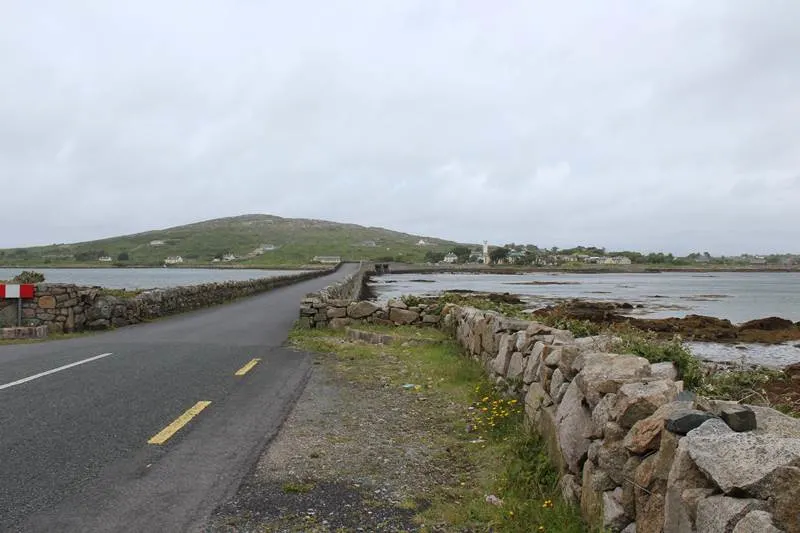
Narrow Bridge ahead
But sometimes there are signs that leave you wondering about the meaning:

This sign is to alert you that you can expect children crossing.
or

I think this last one, though it looks like someone doing the collection in church, actually indicates that there are men at work and operating manual stop-go signs like this:

Workers in countryside roads
Yes, they still do it like that over here! Note in this photo they are stopping traffic from both directions!
There are also signs that look as if they have been invented by the local inhabitants!! No idea what this one means. ‘Warning’ maybe?
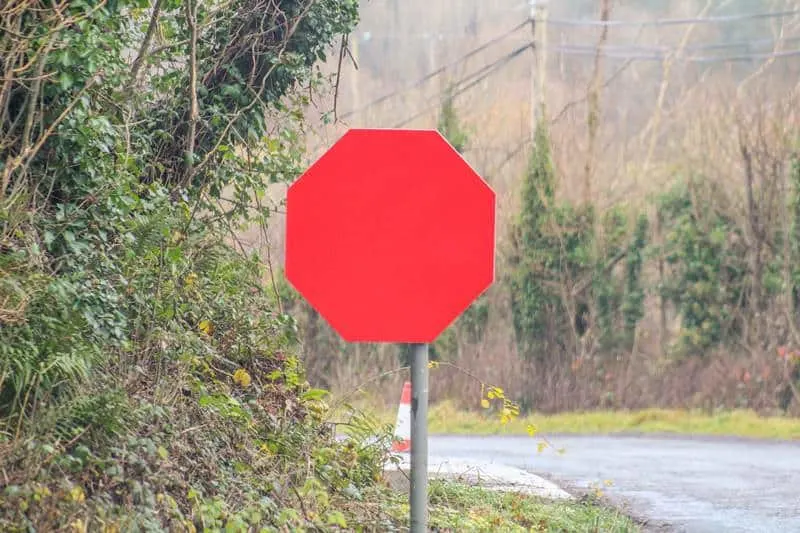
And there are signs where you just have to wonder ‘what were they thinking’, like this one below?! A no-overtaking sign on a single track road 😄!

Single-track road with a no-overtaking sign
-
Backroads in rural Ireland
You may wish to avoid the backroads as they are often much narrower than the main roads. We think they are fun to drive, but sometimes they can be very narrow and you may have to slow down to pass cars coming from the opposite direction.
You need to be good at hugging hedgerows, which you may not wish to do if you are driving a rented car. Also, some of the roads do not have any barriers to stop you leaving the road which can be dodgy if there happens to be a cliff there!
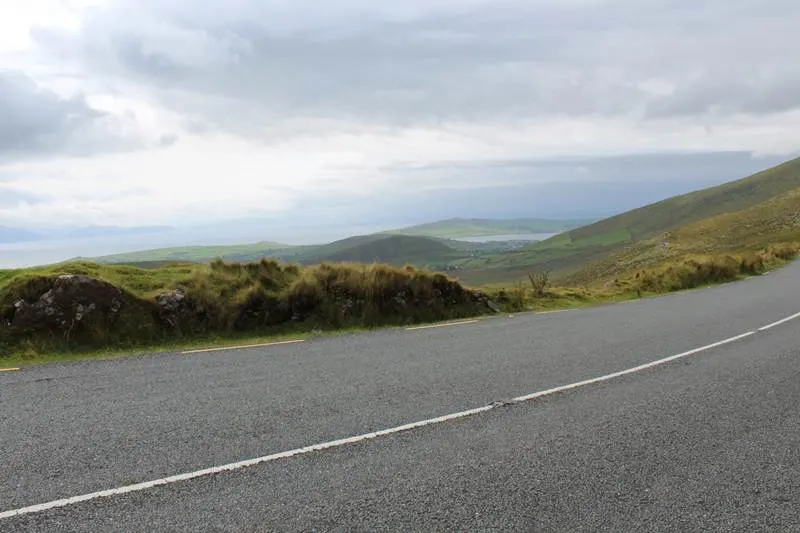
Countryside roads usually don’t have hard shoulders
Some of the roads may have grass growing in the middle, or may be badly potholed so you certainly have to be careful if you are driving a motorcycle.
However, sometimes if you wish to get to cool places, you have to follow these roads.
Just be aware that they are not designed for turning around, so make sure you only turn at a place when you will not impede or hold up other drivers.

One-lane road that permits two-way traffic but is not wide enough to allow vehicles to pass one another.
In rural Ireland, where we are, on the Wild Atlantic Way in county Clare we are lucky not to have too much traffic.
You may get held up by cows changing fields or tractors. Not much more than that. So you just have to be patient. Rushing will not get you anywhere fast.
Also, it is wise to avoid roads that may look a bit too much of a challenge.
This hill below, exciting as it looks, really was very steep and would have been quite dangerous had it been raining. There was certainly nowhere to turn around if it had started.

Steep hill in Ireland
Is it safe to drive in Ireland?
Now, this is quite subjective. We have lived in a few countries in Europe plus traveled to the majority of EU countries where we drove extensive on both right and left hand sides.
We drive daily here and while we haven’t had any accidents there are some things you should keep in mind when driving in Ireland (check out the alarming statistics I will talk more about below).
My concerns are related to the fact that are is plenty of people without a diving’s license here, also without proper car insurance (insurance in Ireland is day light robbery) and without performing proper maintenance in their cars. I will talk more about this below.
I don’t say that to alarm you or stop you from driving here! No! But you will want to be extra attentive while driving and perhaps leave more space between the car in front of you, just in case.
-
Learner Drivers
Another thing to watch out for in Ireland are cars with an L, N or R plate.
These are big red on white stickers normally placed in the windscreen of the car to warn others drivers that there is either a ‘Learner’ or ‘Novice’ driver driving, respectively.
Learners are drivers without a full licence who have to have an experienced driver sitting next to them (not that that really helps much). Novice drivers are drivers that only passed their test in the last two years. In Northern Ireland you may see R (restricted) plates, which are like N plates.
Some statistics you need to know:
During the 5 years after 2007, 11,8% of drivers involved in serious accidents were learner drivers. In the UK 20% of novice drivers crash in the first 6 months after passing their test.
These statistics would imply that it would be wise to give these cars a wider berth than one normally would do. Especially when one knows that quite a lot of people in Ireland drive on L plates because they have failed their test multiple times, or have never taken a test.
Some people book a test every year in order to get their provisional license, and then cancel the test and drive unaccompanied with L plates. They do this because in some parts of Ireland you NEED a car to get around as there is no public transport.
In fact in 2019 more than 1,600 cars have been impounded from unaccompanied learner drivers and more than 2,300 people received fines and penalty points on their license for not displaying L plates
There were more than 41,000 people on their 4th or more learner permit and of these more than 8,500 on their 10th successive learner permit.
This basically means people do not take their driving tests, they just renew learner licenses and drive unaccompanied!
Quite shocking really to think that people can get away with it!!!! But the lack of proper enforcement means that less prepared drivers are out there.
Knowing this means you should be more aware of all cars around you. If someone appears to be driving erratically, you never know, they could be one of these drivers.
Just keep clear to be on the safe side. Certainly do not make things worse by tailgating, hooting at them or flashing lights.
On that point, if someone flashes lights at you it could mean a number of things: either one of your lights is not working or there is a speed trap around the corner.
And remember, always wear your seat belts! It is a legal requirement.
Hiring a car in Ireland
If you are flying in, you are most likely going to be hiring a car here.
Be aware that often the car rental companies may include a collision damage waiver (CDW) insurance for free. However, you need to be aware that this normally only partly covers you in the event of damage or theft of the vehicle.
There will probably be an ‘excess’ involved in the policy (i.e. the amount you will still have to pay in the event of damage). You can however also insure this with a damage refund insurance.
At the care hire desk you will be really ripped off for this extra insurance, which may cost as much as the car hire itself. You are much better off buying this separately beforehand at any of the companies offering this online.
When you pick up your car make sure you check for any damage and scratches and report that on the paperwork you are provided with so that you do not have to pay for something you did not cause.
Rental cars has great Trustpilot reviews which is great to check before you choose which rental company to use. The more reputable ones such as Hertz tend to be more expensive but provide a better overall service.
Click here to compare car rentals with high Trustpilot reviews
You probably need to be at least 21 to hire a car in Ireland. Check this before you leave. Make sure you have good travel insurance, just in case.
-
Driving License requirements
You can drive in Ireland with a US or EU driving license as long as it is valid, but you probably need to be at least 21 years old. Younger drivers will pay a surcharge because of the extra insurance risk.
Do you need an international driver’s license in Ireland? Or international drivers permit? This all depends on where you are from. This link provides some more information and guidance on what types of license you need to have to drive in Ireland.
-
Parking
Parking in the rural towns is not normally much of a problem. Just read the local regulations before parking and pay at the meter if required.
Parking in Dublin, however, is another matter. If you are staying in Dublin outside the city center you may have access to a parking space. If you are anywhere near the city center, you probably will not and it may even be worth just relying on public transport for the days you are in the city.
There are some municipal car parks which may cost you up to 35 euros for 24 hours if you have not booked upfront. If you book earlier you may get a parking space for around 15 euros for a day.
You need to plan it upfront to get the best deal and reserve a place. Be aware, driving in Dublin, Ireland is not much fun and on some roads in the centre you are likely to be held up. If you can avoid it during your trip to Dublin, do.
In some towns you may see a sign with free disk parking for a limited period. Then it is normal to use a little blue disk with an inbuilt rotatable clock that indicates the time. You set the time when you arrive and have to be back before the time limit has expired otherwise you risk a parking fine.
This is normally only actioned in busy towns, or in high season, but do not take my word for it. If you are hiring a car, make sure you ask the hire company if they have a disk available for you in the vehicle.
General Driving in Ireland tips
So just remember you are not the only person on the road. Many Irish lanes do not have a sidewalk so you may be surprised by people walking on the side of the road.
In some towns, (Limerick for example) you may see horse and carts on the road or even horses grazing in the central reservation. Often you may see cyclists (often tourists) on the country roads who may need a bit of space. Give them as much space as you can.
You obviously need to adjust your speed to account for these, perhaps unexpected, situations. Be courteous to others and others will be courteous back – this is the general rule of the road. I remember my driving instructor teaching me ‘drive so that you do not cause anyone else to have to brake’. I always thought this was good advice. So if you ask ‘is driving in Ireland safe’? I would still say ‘it is as safe as you want to make it’!
Final tip – do not drink and drive. A blood alcohol concentration of 50-80mg will get you an automatic driving disqualification and a fine.
I hope some of these travel tips help you to enjoy your trip through the beautiful Island of Ireland and that you have some safe and exciting travels. Self-driving Ireland is a fantastic way to have an exciting holiday.
If you want the best trip ever, try driving the Wild Atlantic Way along the West coast of Ireland. This link will give you free downloadable routes to follow in all the Counties along the Wild Atlantic Way.
More Ireland itinerary posts
PIN FOR LATER!

